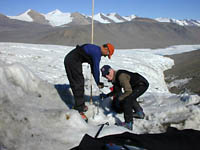|
How
to Melt a Glacier
|

|
by
Mary Miller
January
4, 2002
The
first thing you notice when you fly into the Lake Hoare field
camp in the Dry Valleys is the Canada Glacier. It’s like
a living, breathing presence, a wall of steep white ice atop
a lake the color of a blue tourmaline gemstone. When we hop
out of the helicopter after a twenty-minute ride from McMurdo
Station, I’d like to gawk at the glacier and the incredible
landscape of the Dry Valleys, but there’s work to be
done first.
After
we unload gear from the helicopter and wave goodbye to our
pilot, we get a quick orientation of the area by camp manager
Rae Spain. Rae has been working out in the Dry Valleys for
four years (she’s one of the pioneering women of the
Antarctic program and has spent twenty seasons on the continent),
and she outlines the camp rules for us. We are to leave no
trace of our presence here, except for footprints.
Everything
brought into the valley must be brought back out, including
all cooking and washing water and human urine and solid waste,
all of which is collected in barrels and flown back to McMurdo
for disposal. We also can’t take any souvenir rocks home
with us, which is a tough rule because the rocks here are
so beautiful and unique. We must content ourselves with taking
pictures instead.
The
reason for this environmental code of ethics is that this
unique and starkly beautiful place contains a very delicate
ecosystem. The Dry Valleys is a study site for intensive environmental
research, one of twenty-four Long Term Ecological Research
(LTER) projects in the United States. This site is particularly
important because it represents the only polar desert ecosystem
being studied and has been largely untouched by human presence.
|
|

|
|

|
Paul
drills a hole that will help monitor the mass of the glacier.
Click
to enlarge
.
|

|
|
|
|

|
After
we get a lay of the land and have some lunch, geologist Andrew
Fountain takes me on a walking lesson in glaciology. Andrew,
a professor from Portland State University, has been studying
the Canada Glacier at Lake Hoare and other glaciers in the
Dry Valleys since 1993. As one of the project scientists for
LTER, it’s Andrew’s job to understand the role of
glaciers in the Dry Valleys ecosystem. In the coldest, driest
desert on earth, glaciers are the only source of water to
the lakes and soils here. With water comes life: This delicate
ecosystem is built upon single-celled microbes and algae,
which in turn support larger life forms such as nematode worms,
rotifers, and tardigrades.
Even
the tops of the glaciers provide a refuge for life. As soil
is blown across the valley floor, it collects on the glacier,
creating little pools of dirt and water called cryoconites.
These little pools harbor their own complete ecosystems of
microbes and invertebrates, some of which can live there for
years without making it to the valley floor. Such are the
extreme conditions for life in an ecosystem that has been
compared to Mars.
|

